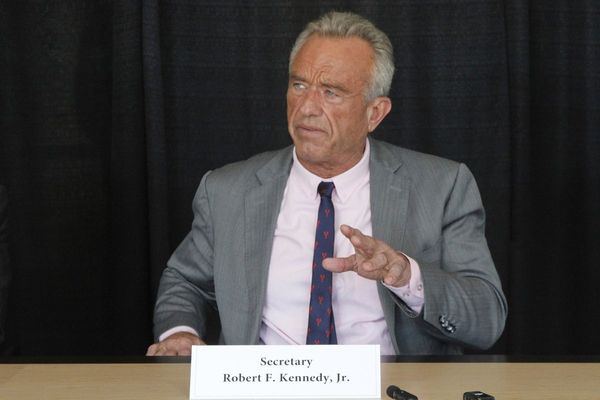
I was cycling through Walton-upon-Thames in Surrey earlier this month, when I went past some striking ambulance workers on a GMB picket line. It’s hard to signal your support on a bike, particularly when you don’t have a bell. Happily, every passing car was honking, every single one. Yet this was the affluent home counties, and ambulance workers have, historically, been the least popular people to go on strike. You don’t call an ambulance unless you really need one, so it’s hard for people to imagine the ambulance worker who isn’t essential.
When the BBC has a day-by-day planner to show who’s on strike; when three of the least radical professions on earth are withdrawing their labour (physiotherapists, meteorologists and driving examiners); when you’re planning a night out with an eye on whether the trains are running, you might expect that public support for industrial action would be at an all-time low. The opposite is true: support for striking nurses and ambulance workers is running at 66% and 63% respectively. Almost three times as many people blame the government as blame the unions. Union hardship funds are raising hundreds of thousands of pounds from general donations. Resistance is back, and it’s organised; it has support, dignity, solidarity. It is taking shape in union action, and answered in civil society, with the Don’t Pay campaign and Enough Is Enough. The creed of flag-waving stoicism, belt-tightening for Britain, with all its paraphernalia, its scones, bunting, mugs and allotments, has fallen apart. Nobody wants to keep calm and carry on.
The new mood is commonly ascribed to the new national circumstance: soaring inflation, unaffordable energy, eye-popping food bills. Yet people are not so much amorphously angry at interest rates or geopolitics – they are squarely rejecting the government, its intransigence and parsimony, its unjust policies.
The Tories have got away with it for almost 13 years, though, ever since David Cameron came to (partial) power with the stated promise of austerity, pledging exactly the callous and miserly government he delivered. From 2010, local authorities lost a huge amount of funding, disabled people had their care packages reduced and their benefits decimated by faceless, unaccountable private companies, renters had their housing benefit reduced, social tenants faced the bedroom tax, the social safety net was shredded to the point that food banks proliferated, public services withered and public sector wages were frozen. Yet, for more than a decade, the range of acceptable response ran from complacency to endurance. Anger was not British, because anger was not calm.

Created in 1939 to raise wartime morale but never publicised until 2008, when the poster was first mass-produced, the Keep Calm and Carry On message swiftly became inescapable. As Owen Hatherley describes in his book, The Ministry of Nostalgia, it became “a canvas on to which practically anything can be projected while retaining a sense of ironic reassurance”. The world of merch certainly tested this theory, with its “Keep calm and join Isis” hoodies, and “Keep calm and love blowjobs” beach towels. But the meme was perfect as a backdrop for the vacuous Cameron, who seems to have divined in its popularity a public willingness to embrace frugality as a nice, Blitzy, quintessentially British thing. “Austerity” as a word distilled that wartime fetish, giving the voters a warm, nostalgic feeling, even as the poorest paid for the mistakes of the richest.
There was a certain cunning to Cameron’s approach, visible in both that effortless marshalling of the zeitgeist and the careful creep of his cuts, hitting hard the most vulnerable and marginalised first, rather than distributing the pain between a larger number of more vocal, or rather, more listened-to people. The other buzz phrase, of course, was “We’re all in this together,” another nod to the heady wartime notion that hardship was unifying. This surfaced in Cameron’s last conference speech as leader of the opposition, and was the most directly dishonest description of his plans: a lot of people in this low-interest rate, triple-locked pensions era were going to do absolutely fine under his “austerity”.
That administration was wily, too, in the way it preempted its own sadism with narrative accounts of why people might deserve their hardship. The benefit fraudster was already a trope when the cuts hit; the inadequate parent, who couldn’t cook from scratch or budget, was the bane of early years policy by the time food banks were on the rise. But it needed an answering cult of masochism, and it got that from the people who weren’t feeling the pain. That’s how we ended up valorising a wartime slogan that was entirely ersatz, never used in the war: it’s a fake stoicism, for other people’s suffering. Cameron and his cabinet deployed it for absolutely everything. Terrorist attack foiled in Merton? Keep calm and carry on!
“It still feels hard to describe how heavily policed the public conversation was around austerity,” says Ellie Mae O’Hagan, head of public engagement for the Good Law Project. “There was just no room in mainstream public conversation to question it. You had Nick Pearce [then head of the Institute for Public Policy Research] calling it ‘fiscal realism’. You had Sky News running a deficit ticker. You had the Labour party agreeing with the principle. The whole political and media sphere was agreed: tough choices had to be made – there was no alternative.”

Of course, plenty of people were angry from the start, and even though they were given no quarter in the mainstream discourse, that didn’t stop protests, demonstrations, riots. At the end of 2010, the protests against tuition fees began; they were absolutely monstered in the press, as academic Luke Cooper, now 38, remembers. “The day after Millbank, the Evening Standard ran a front page with me on the cover saying, ‘Full marks for riot, say lecturers.’ They pegged me as a violent person of bad character, and I sued them [and the Daily Mail] for 60 grand and won.” That satisfaction is a side dish to his main point: “The monstering was itself angry. There’s nothing quite as angry as a tabloid editorial. It’s important to recognise that there was anger on both sides. At least there was more content to progressive anger.”
The rightwing papers didn’t so much dispute the civic rage as completely dwarf it with their own. The Mail called the students a “baying rabble of masked and hooded troublemakers” and at one point tried to infiltrate the activists, sending a journalist to pose as a volunteer with learning disabilities, according to Michael Chessum’s book about Britain’s new left, This Is Only the Beginning.
At the harder and more consequential edge, policing and justice meted out to the angry were harsh and swift. As Matt Myers, who was involved in the protests, describes in his book Student Revolt: Voices of the Austerity Generation, “Among the Manchester contingent – totalling 450 people brought down in nine coaches – one student had a broken collarbone, another a broken arm and a third a broken ankle. All were caused by police violence.”
Less than a year later, after the riots sparked by the Metropolitan police’s killing of Mark Duggan, I sat in an all-night court and watched a terminally ill cancer patient with tumours on his face remanded in custody for picking up some cigarettes through a shop window someone else had broken. Another man was refused bail after being found with an Oyster card not registered in his name. It was unbelievable how merciless the state was, after that wave of disorder. There was no period of reflection by the Met; the government asked itself no questions about deprivation, the closure of youth services, the wider relationship between the police and communities.
When Brexit rolled around, however, public anger was suddenly in vogue. The trope of the righteously angry was established as the organising principle of debate: you were allowed to be angry if you were “left behind”, if you lived in the so-called red wall, if you were white working class. You weren’t allowed to be angry if you lived in Tower Hamlets, or you weren’t white. By wild coincidence, the arbiters of legitimacy had exactly the same concerns as those they deemed legitimately angry: it wasn’t about low wages, it was about migrant labour forcing wages down; it wasn’t about the degradation of public services, it was about money going to Brussels that should be going to public services. The steady impoverishment of households and the public sphere was biting hard and no longer possible to ignore, so rather than deny an anger that was by then palpable, Brexiters used it to destroy pluralism.
Meanwhile, the nostalgic, patriotic regalia of the second world war, first deployed to reconcile the nation to spending cuts and state cruelty, was now repurposed for a debate to which it was actually better suited: Britain was exceptional and plucky, Germany was her enemy, she would never surrender. What had once been ironic – union flags used playfully, in 90s’ Spice Girls fashion – became unironic, the nation’s most senior politicians on both sides draping themselves in red, white and blue. When Boris Johnson performed this jingoistic fantasia, he seemed always to skirt the line between joking and not joking. Not until Liz Truss’s era did it become incontrovertibly sincere, and it was fortunate that she was undone by her own incompetence before the full ramifications of this overheated nationalism could be felt. That’s what I tell myself, anyway, now my mortgage has doubled. Look on the bright side.

What finally did for the many fantasies of the past 13 years was Covid. First, it unmasked how much public services had been degraded, deliberately by cuts and accidentally by carelessness. Then it destroyed the myth that the low-waged were somehow less valuable, less hard-working, less patriotic, less than: a nation relied entirely on the courage of delivery drivers, bus drivers, nurses, many of whom paid with their lives. The death of Belly Mujinga, who worked for Govia Thameslink rail and died of Covid after a customer allegedly spat at her, forced the question of gratitude back into a sphere from which it had been erased. Public servants, people on minimum wage, people doing the kind of jobs you couldn’t do from home – all these people vilified, subtly and unsubtly, by the government – were actually keeping the whole show on the road.
The Conservative party, meanwhile, was enriching its friends to a head-spinning and, more to the point, increasingly visible degree. The corruption of dodgy PPE contracts, the lies of Partygate, the questionable tax affairs of very prominent officials (the prime minister’s wife with non-dom status? Nadhim Zahawi in dispute with HMRC while he was chancellor? Come on!): it all coagulated into this clump of dishonesty, the extent of which just keeps on growing. The final irony is that, because these incredibly insulated politicians have largely forgotten the pandemic, they think we have, too. They’ve forgotten that they were on their doorsteps clapping for carers; they’ve forgotten the trip to Durham, and suitcases full of booze in Downing Street, and the scandals over the VIP lane for contracts. They’ve filed all this under “yesterday’s news”. They live in a perpetual present where every new scandal is self-contained, unrelated to what went before. But to the millions who felt them, the wounds of the pandemic are deep, and memories not so casually erased.
Public servants are furious across every sector, but so is everyone else: people whose wages have declined in real terms, people who use electricity, people who pay rent, people with mortgages, people who use food banks, people who eat food. There is a burning, broad-based sense of injustice that cross-pollinates between different sectors, classes and generations and is only in its opening stages of getting organised. It won’t keep calm, but I think it probably will carry on.
• This article was amended on 24 January 2023, to refer to ambulance workers rather than to “ambulance drivers”, and because it is driving examiners who are striking, not “driving instructors” as an earlier version said.







